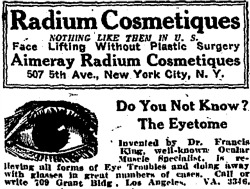


Testing your home for radon (a radionuclide in gas form) and taking steps to reduce the radon level can be one of the most important things you can do to reduce your contact with natural radiation. Flying in airplanes, living at high altitude, living near a coal mine, and some jobs (like underground mining) put you in contact with higher doses of radiation. Your lifestyle can also affect how much radiation you come in contact with. For example, a radiation medical treatment has an extremely high dose of radiation compared to the very low dose of radiation you get from drinking water with radionuclides. Each source of radiation gives you a different dose of radiation. The other half comes from human-made sources, like medical tests (x-rays) and treatments and building and road construction materials. About half of the radiation you come in contact with each year is from natural sources, like the sun, soil, and rock. Web number of isotopes (atoms of the same element with a different number of neutrons): Web facts about radium radium is one of the those elements that can make. Natural and human-made radiation surround you every day. You can call your community water system to get a paper copy of your CCR, or you may be able to find it online at Find Your Local CCR. You can find the levels of radionuclides your community water system detected by reading their Water Quality Report (also known as a Consumer Confidence Report ). Contact MDH (65 or with questions.Ĭommunity public water systems (systems serving where you live) test for radionuclides and ensure levels meet EPA standards. You can learn more about treatment systems at Home Water Treatment. Home water treatment systems, like ion exchange water softeners and reverse osmosis systems, can reduce the levels of some radionuclides in your water. You can use the standards in the Radionuclides Rule for your private well. You can also contact your county to see if they have any programs to make testing your water easier.
#Facts about radium how to
Contact a Minnesota Department of Health (MDH) accredited laboratory to get a sample container and instructions on how to submit a sample. If you are concerned about radionuclides in your private well, you can pay to have it tested through an accredited laboratory. The factors that contribute to the presence of radionuclides in Minnesota's well water are not well understood at this point. 4 millirem of beta/photon emitters per year (mrem/yr) or less.5 pCi/L of combined radium 226/228 or less.15 picocuries of alpha particles per liter of water (pCi/L) or less.Environmental Protection Agency’s (EPA) Radionuclides Rule has four federal standards for radionuclides in drinking water.


 0 kommentar(er)
0 kommentar(er)
